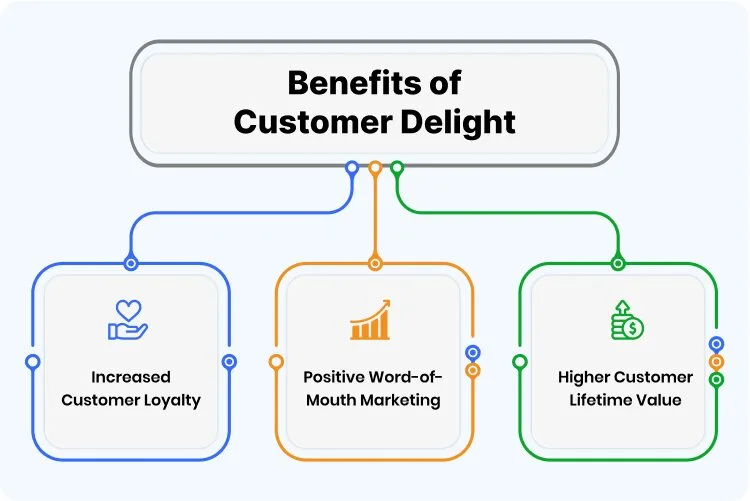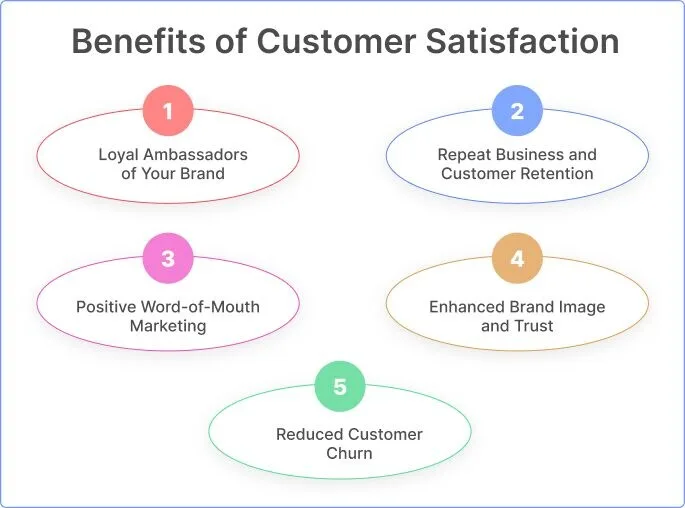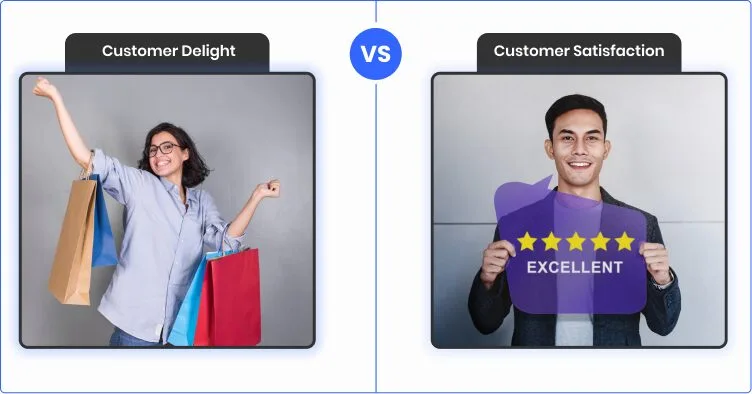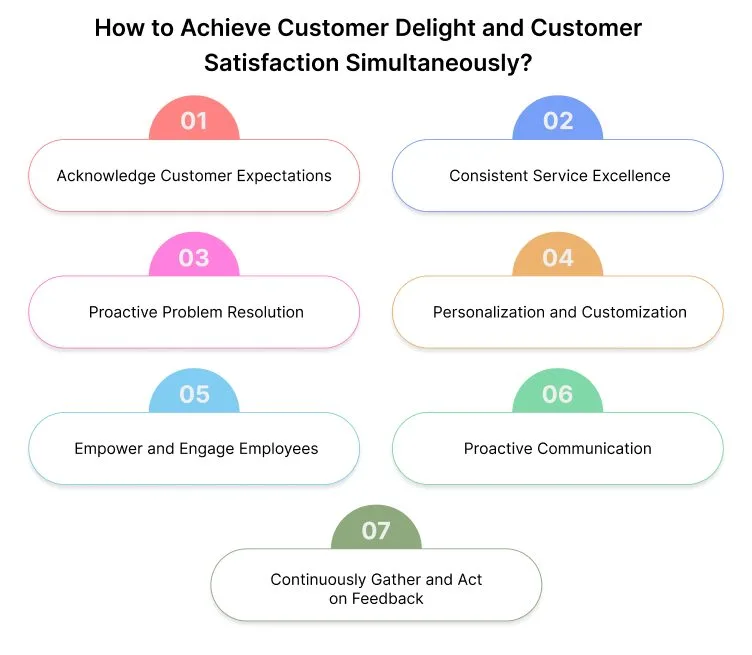Customer Delight Vs Customer Satisfaction: What Are Differences?
- January 31, 2024
- 18 mins read
- Listen

Table of Content
A satisfied customer is content, but a delighted customer becomes a brand ambassador and echoes far beyond the transaction. Recent industry insights indicate a seismic shift in focus, with businesses recognizing that the magic lies not just in satisfying customers but in delighting them. Customer loyalty to positive word-of-mouth, the benefits are not merely transactional; they’re transformative.
Brands with superior customer experience bring in 5.7 times more revenue than competitors that lag in customer experience.
In this article, we’ll provide a breakdown of customer delight vs customer satisfaction with examples, benefits, and more.
What is Customer Delight?
Customer delight is to create a profound emotional connection between customers and brands. It’s about making experiences that not only meet expectations but surpass them. And it leaves a lasting impact. Delight is the surprise, the personalized interaction, and the commitment to consistently exceed standards. Think of it as the joy, the wow factor, and the genuine connection that transforms a transaction into a memorable journey.
Personalized gestures, surprising perks, and quick, efficient problem resolution are the hallmarks of delightful experiences. The benefits are substantial — delighted customers become loyal advocates, share positive experiences, and contribute to higher customer lifetime value.
Measuring delight involves tools like Net Promoter Score (NPS), customer feedback, and social media engagement. Customer delight is the art of creating moments that resonate to foster loyalty and positive word-of-mouth marketing. It’s not just about satisfying; it’s about captivating and leaving a lasting impression.
Examples of Customer Delight
Now let’s take a look at some examples that showcase how small, and thoughtful touches can make a big difference in turning a transaction into a memorable and delightful customer experience.
1. Personalized Interactions
It is a key element of customer delight, where brands tailor interactions based on customer preferences and past behaviors. For instance, an e-commerce platform might recommend products based on a customer’s purchase history. It creates a sense of being valued and understood.
Your personalized interactions extend beyond product recommendations to include communication tone, marketing messages, and even the design of user interfaces. All are contributing to a more customized and enjoyable experience for the customers.
You can use an AI-powered chatbot to deliver personalized experiences to customers across their journey with your brand. Using advanced AI-chatbots like those from REVE Chat can help you leverage customer data and information to deliver personalized experiences.
2. Surprising Perks or Gifts
It often involves going the extra mile by offering unexpected perks or gifts. This could range from bonus discounts during checkout to exclusive gifts with purchases. Subscription services, for example, might surprise customers with an additional month of free access or send limited-edition merchandise as a token of appreciation.
These surprises not only enhance the customer’s perception of value. Also, it creates a sense of excitement and gratitude.
3. Quick Problem Resolution
While solving problems is a standard part of customer service, the manner and speed with which issues are addressed can significantly contribute to customer delight. Just imagine a scenario where a customer encounters an issue with a product or service, and the customer support team resolves the problem promptly.
Besides, they added a little extra, such as a discount on the next purchase or express shipping for a replacement.
Benefits of Customer Delight

When brands delight customers, basically they cultivate a loyal customer base that not only sustains but actively contributes to the growth and success of the business. Let’s explore some key benefits of delighting customers.
1. Increased Customer Loyalty
You know a delighted customer is a potent driver of customer loyalty. When customers experience moments of delight, where their expectations are not just met but exceeded. They are more likely to develop a strong emotional connection with the brand.
This emotional bond fosters loyalty and encourages customers to stick with a brand for the long term. Your delighted customers become not just repeat buyers but enthusiastic advocates. They actively promote the brand to friends, family, and their social circles.
2. Positive Word-of-Mouth Marketing
When customers are delighted, they become powerful ambassadors for a brand and contribute to positive word-of-mouth marketing.
Your satisfied customers may share their experiences, but delighted customers go a step further by actively recommending the brand to others. Word-of-mouth recommendations, facilitated by social media, reviews, and personal conversations, carry significant weight and can influence potential customers. This organic form of marketing is invaluable, as it builds trust and credibility in the eyes of new customers.
3. Higher Customer Lifetime Value
The impact of customer delight extends beyond individual transactions. And, it influences the overall customer lifetime value (CLV). They’re more likely to engage in repeat business and make additional purchases over time.
Moreover, their positive experiences make them receptive to upselling or cross-selling efforts. The cumulative effect is a higher CLV, as these customers contribute more revenue over their relationship with the brand compared to merely satisfied customers.
How to Measure Customer Delight?
It involves a combination of quantitative and qualitative methods. Each offers a unique perspective on the emotional connection between customers and a brand.
1. Net Promoter Score (NPS)
It is a widely used metric to measure customer delight. It measures the likelihood of customers recommending a brand to others. Customers are typically asked a simple question: “How likely are you to recommend our product/service to a friend or colleague?”
The responses categorize customers as promoters (score 9-10), passives (score 7-8), and detractors (score 0-6). The NPS is calculated by subtracting the percentage of detractors from the percentage of promoters.
A high NPS indicates that customers not only find the brand satisfactory but are actively delighted. It results in positive word-of-mouth and potential brand advocacy.
2. Customer Feedback and Testimonials
It provides valuable insights into the emotional impact of interactions. Feedback forms, surveys, and customer reviews capture sentiments beyond satisfaction. Positive feedback that includes expressions of joy, surprise, or gratitude often indicates instances of delight.
Monitoring and analyzing these qualitative responses help businesses understand specific aspects of their offerings or interactions that contribute to customer delight.
3. Social Media Engagement and Mentions
These platforms serve as real-time indicators of customer sentiment. Monitoring social media channels for customer mentions, shares, and engagement provides a dynamic snapshot of customer delight. Also, viral content, positive comments, and user-generated content related to the brand are indicative of a delighted customer base.
Metrics such as likes, shares, and comments can be quantified to gauge the extent of customer engagement and the brand’s emotional resonance.
What is Customer Satisfaction?
It is a measure of how well a product, service, or overall experience meets or exceeds the expectations of a customer. It reflects the customer’s perception of the value received about their expectations before, during, and after a purchase or interaction with a brand.
In simpler terms, when a customer is satisfied, it means their needs and requirements have been fulfilled, and they perceive the overall experience as positive.
Key aspects of customer satisfaction include the quality of the product or service, the efficiency and effectiveness of customer service, the ease of the purchasing process, and the brand’s ability to meet or exceed the customer’s expectations. Customer satisfaction is often measured through various methods, such as customer surveys, feedback forms, reviews, and other customer-centric metrics.
You should remember that high levels of customer satisfaction are associated with positive outcomes for businesses, including customer loyalty, repeat business, positive word-of-mouth marketing, and an enhanced brand reputation. Monitoring and prioritizing customer satisfaction are crucial elements of a customer-centric approach, as satisfied customers are more likely to become loyal, long-term patrons of a brand.
Characteristics of Customer Satisfaction
You cannot ignore that building and maintaining high levels of customer satisfaction is vital to fostering customer loyalty and creating a positive brand image. Let’s take a look at the characteristics of customer satisfaction.
1. Meeting Expectations
At its core, customer satisfaction involves meeting the expectations of customers. It signifies that the product, service, or overall experience has met the customer’s anticipated level of quality, performance, or service.
2. Consistent Product or Service Delivery
It is a key characteristic of customer satisfaction. Customers expect a reliable and uniform experience each time they interact with a brand. Whether it’s the quality of a product or the efficiency of a service. Consistency always builds trust and contributes to overall satisfaction.
3. Fulfillment of Basic Needs
It is often associated with the fulfillment of fundamental needs. This includes the functionality of a product, the effectiveness of a service, or the resolution of a problem. You need to satisfy these basic needs and create a foundation for a positive customer experience.
4. Reliability and Dependability
It is a hallmark of customer satisfaction. Customers value brands that consistently deliver on promises and commitments. A reliable brand is one that customers can depend on for a consistent and positive experience. This reduces uncertainty and builds trust.
5. Efficient Customer Service
It extends beyond the product or service itself to include the quality of customer service. Efficient and effective customer support, quick response times, and the ability to address issues promptly contribute significantly to overall satisfaction.
Examples of Customer Satisfaction
What truly contributes to customer satisfaction? Let’s take a look at some examples that showcase how various aspects of the customer journey increase customer satisfaction levels.
1. Seamless Shopping Experience
Just imagine, you’re effortlessly browsing an online store, finding the product you need with intuitive navigation, and completing the purchase with just a few clicks. A brand that provides a wow shopping experience contributes to customer satisfaction.
You can create a user-friendly website with a hassle-free checkout process to meet the customer’s expectations. It creates a sense of satisfaction that lingers beyond the purchase.
2. Prompt and Polite Customer Service
Just put yourself in customers’ shoes, that you’re having an issue with a product and reach out to customer service to receive a quick and courteous response. You need to create that level of prompt customer service for your customers to increase customer satisfaction.
Brands that prioritize efficient and friendly customer service contribute to customer satisfaction. Whether it’s resolving a problem, answering inquiries, or providing guidance. The responsiveness of customer support plays a pivotal role in leaving customers satisfied and valued.
3. Consistent Product Quality
Consider a scenario where you purchase a favorite product and every time you buy it, the quality remains consistently high. Brands that maintain a standard of excellence in their products or services contribute to customer satisfaction.
Consistency in quality not only meets but exceeds customer expectations to increase customer trust and loyalty.
4. Reliable and On-Time Deliveries
Just think for a minute, you’re ordering a product online and receiving it exactly when promised. Brands that excel in reliable and on-time deliveries contribute to customer satisfaction. Meeting delivery expectations, whether through accurate estimated arrival time or efficient shipping processes enhances the overall customer experience and leaves a positive impression.
Benefits of Customer Satisfaction

Satisfied customers are not just consumers; they are integral contributors to the growth, stability, and positive reputation of your brand.
1. Loyal Ambassadors of Your Brand
You know this transforms ordinary buyers into loyal brand ambassadors. A satisfied customer makes repeat purchases and actively promotes your brand to their friends, family, and social circles. These loyal advocates become a living testament to the positive experiences your brand consistently provides. It contributes to organic word-of-mouth marketing.
2. Repeat Business and Customer Retention
Do you know that satisfied customers not only make initial purchases but keep coming back for more? It increases customer loyalty resulting in repeat business and increased customer retention rates. This ongoing relationship contributes significantly to the overall revenue and stability of your business.
3. Positive Word-of-Mouth Marketing
Happy customers always share their positive experiences across various channels, from social media platforms to casual conversations. Positive word-of-mouth marketing is a powerful benefit of customer satisfaction.
They willingly become brand advocates to influence potential customers who value recommendations from trusted sources. This positive buzz can result in increased brand visibility and attract new customers.
4. Enhanced Brand Image and Trust
You should always treat customer satisfaction as the artist painting strokes of positivity across your brand canvas. Your satisfied customers contribute to an enhanced brand image. So, always create a reputation for reliability and excellence.
This positive perception builds trust among existing and potential customers. Also, it makes them more comfortable engaging with your brand and choosing your products or services over competitors.
5. Reduced Customer Churn
When customer dissatisfaction is minimized, it results in a significant reduction in customer churn. Your satisfied customers are less likely to seek alternatives. This reduction in churn not only saves acquisition costs associated with attracting new customers. It ensures a consistent revenue stream from existing ones.
How to Measure Customer Satisfaction?
Businesses need to measure the effectiveness of their products, services, and overall customer experience. Here are various methods and tools commonly used to measure customer satisfaction:
- Customer Surveys: You can deploy customer satisfaction surveys as a direct and effective method. These surveys are often conducted through emails or embedded on websites. You can use questionnaires to gather feedback. Common survey types include Net Promoter Score (NPS), and Customer Satisfaction Score (CSAT).
- Net Promoter Score (NPS): It measures the likelihood of customers recommending a product or service to others. Customers are asked a simple question: “How likely are you to recommend our product/service to a friend or colleague?” Their responses categorize them as promoters, passives, or detractors. It provides a numerical score that reflects overall satisfaction.
- Customer Satisfaction Score (CSAT): It measures customer satisfaction based on a specific interaction or experience. Customers are typically asked to rate their satisfaction on a scale, often from 1 to 5 or 1 to 10. This score provides a quick snapshot of how customers perceive a particular product, service, or interaction.
- Online Reviews and Ratings: You should always monitor and track online platforms for customer reviews and ratings. It provides a qualitative measure of satisfaction. Platforms like Yelp, Google Reviews, and industry-specific review sites can offer insights into customer sentiments and overall satisfaction levels.
- Social Media Monitoring: You need to keep your eyes open on social media mentions and comments. It is related to your brand and provides real-time feedback. Customers may express their satisfaction or dissatisfaction on platforms like Twitter, Facebook, or Instagram. It offers valuable insights into public perceptions.
- Customer Feedback Forms: You can use customer feedback forms on websites or within products/services. It allows customers to provide comments and suggestions. These forms can capture specific details about their experiences and areas where improvements can be made.
- Customer Interviews and Focus Groups: Conducting one-on-one or focus group sessions allows businesses to dive deeper into customer experiences. These qualitative methods provide rich insights into customer perceptions, preferences, and areas of satisfaction or dissatisfaction.
Difference Between Customer Delight and Customer Satisfaction

Customer satisfaction focuses on meeting expectations and ensuring a baseline level of contentment whereas customer delight increases the customer experience by exceeding expectations and creating emotionally resonant moments.
Now let’s have a look at the key differences between customer delight vs customer satisfaction.
1. Essence of Experience
- Customer Satisfaction: It revolves around meeting customer expectations and ensuring that their needs are fulfilled. The focus is on providing a reliable and adequate experience. Where customers get what they anticipate.
- Customer Delight: It transcends meeting expectations. Customer delight involves creating moments that go above and beyond. It surprises customers with unexpected joys and leaves a lasting emotional impact. It’s about crafting an experience that resonates on a deeper level.
2. Emotional Connection
- Customer Satisfaction: It establishes a transactional relationship where the customer receives what was promised. It results in a rational sense of contentment. The emotional connection may not be strong or memorable.
- Customer Delight: It forges a strong emotional bond between the customer and the brand. It involves creating positive emotions such as joy, surprise, or awe, making the customer’s interaction with the brand memorable and emotionally resonant.
3. Meeting vs. Exceeding Expectations
- Customer Satisfaction: It ensures that the product or service delivered aligns with what customers expect and meets the baseline requirements. The focus is on consistency and reliability.
- Customer Delight: It goes a step further by not just meeting but exceeding expectations. Delight involves surprising customers with elements they didn’t anticipate. It increases the overall experience beyond the ordinary.
4. Perception of Value
- Customer Satisfaction: It is often associated with a perceived value for money. Where customers feel they received what they paid for without any major issues. The emphasis is on fairness and meeting the customer’s perceived value.
- Customer Delight: It creates an enhanced perceived value by delivering more than what customers expect. Delighted customers often feel they received additional, unexpected benefits, adding a sense of magic and premium value to their experience.
5. Reactive vs. Proactive
- Customer Satisfaction: It is often reactive and focuses on addressing issues and meeting existing needs. The goal is to prevent dissatisfaction and ensure a smooth customer experience.
- Customer Delight: It is proactive and seeks to exceed customer expectations even before issues arise. Delight involves anticipating customer desires and surprising them with positive gestures. It creates a sense of delight that goes beyond problem avoidance.
How to Achieve Customer Delight and Customer Satisfaction Simultaneously?

In this customer delight vs customer satisfaction comparison, it’s pivotal to know the ways to achieve both. Achieving both requires a commitment to understanding customers on a deep level. But, how will you achieve that? Let’s find it here:
1. Acknowledge Customer Expectations
- Customer Satisfaction: You have to identify the basic needs and expectations of your customers. Conduct market research, gather feedback, and analyze customer behavior to establish a baseline for satisfaction.
- Customer Delight: Go beyond the basics and explore opportunities to exceed expectations. Don’t think only about what customers want but also what could surprise and delight them. This requires a deep understanding of their preferences, desires, and potential pain points.
2. Consistent Service Excellence
- Customer Satisfaction: You need to deliver consistent, reliable service that meets or exceeds your customer expectations. Your products or services consistently perform at a high level to create a sense of reliability and dependability.
- Customer Delight: You can increase your service by adding unexpected touches of excellence. This could involve personalized interactions, surprising perks, or going the extra mile to make customers feel special. Consistency in delight is key to creating memorable and lasting experiences.
3. Proactive Problem Resolution
- Customer Satisfaction: Always respond promptly to customer issues and resolve problems efficiently. A quick and effective customer resolution contributes to satisfaction by minimizing disruptions and demonstrating commitment to customer care.
- Customer Delight: You always have to address customer potential issues before they become problems. Proactive problem resolution involves identifying areas of improvement and addressing customer concerns before they escalate. Your customers will be surprised with resolutions that exceed their expectations.
4. Personalization and Customization
- Customer Satisfaction: Offer personalized experiences based on customer preferences and past interactions. Your communication and offerings to match customer needs to create a sense of understanding and relevance.
- Customer Delight: You can take personalization to the next level by offering unexpected and personalized experiences. This could involve surprise gifts, exclusive offers, or personalized recommendations that go beyond what customers would typically expect.
5. Empower and Engage Employees
- Customer Satisfaction: Your employees will deliver consistent and reliable service if they get trained and empowered. So, make sure they have the necessary skills and tools to meet customer needs and expectations. This article “how to identify customer’s needs” can be helpful for your employees to serve customer more efficiently.
- Customer Delight: You can build a culture of creativity and empowerment among your employees. This will encourage them to go above and beyond in creating delightful experiences for customers. When employees are engaged and motivated, they are more likely to contribute to moments of delight.
6. Proactive Communication
- Customer Satisfaction: Always try to keep your customers informed about relevant updates, changes, or promotions. Clear and transparent communication contributes to satisfaction by managing expectations and providing necessary information.
- Customer Delight: You can surprise customers with proactive and personalized communication. This could include early access to promotions, exclusive previews, or personalized messages that demonstrate a genuine interest in their well-being and preferences.
7. Continuously Gather and Act on Feedback
- Customer Satisfaction: You need to collect customer feedback regularly through surveys, reviews, and other channels. You can use this feedback to identify areas for improvement and make necessary adjustments to enhance satisfaction.
- Customer Delight: Act on customer feedback not just to address your customer issues but to innovate and introduce delightful elements. Actively seek suggestions for enhancements that can bring unexpected joy to your customers.
Conclusion
Customer satisfaction lays the foundation by meeting expectations, it is the infusion of delight that creates unforgettable moments and forges emotional connections.
These days businesses are challenged to not only meet but exceed expectations. Consistent service excellence and proactive problem resolution provide a roadmap for achieving both customer delight and customer satisfaction simultaneously.
Looking forward, the customer-centric future beckons, where businesses become creators of magical moments. Whether you’re at the helm of a startup or an established brand, you should always embrace the challenge, innovate intentionally, and craft experiences that resonate long after the transaction.
With REVE Chat, you can go beyond the basics, and let every interaction be an opportunity to surprise, captivate, and build lasting connections. Sign up with us and explore our top engagement tools and delight your customers.
Frequently Asked Questions
Customer delight and customer satisfaction primarily differ in their impact on the customer experience. With customer satisfaction, the focus is to meet customer expectations and deliver what customers anticipate. On the other hand, with customer delight, the focus is to exceed customer expectations.
Many brands today tailor interactions based on customer behavior and preferences. For example, when you visit an Amazon store, you might find products recommended there based on your previous browsing or purchase history. This can surprise and even delight you in some cases. So, the way ecommerce sites personalize interactions could be a good example of customer delight.
The three major benefits of delighting customers are –
- When customers feel delighted, they develop a strong connection with the brand, leading to increased customer loyalty.
- Delighted customers become influential ambassadors for the brand, share their experiences, and recommend the brand to others.
- When customers feel delighted, they make repeat purchases and this increases customer lifetime value (CLV) for the business
- Meeting the customer’s desired level of expectations through product or service quality
- Maintaining consistency with the product or service efficiency
- Fulfilling the basic needs related to the product or service delivery
- Ensuring reliability to customers at every step of their journey with the brand
- Delivering efficient customer support
Delivering products on time, responding to customer queries promptly, ensuring a seamless shopping experience, and maintaining standard communication etiquette are some good examples of customer satisfaction.



